![]()
![]()
![]()
Use LEFT and RIGHT arrow keys to navigate between flashcards;
Use UP and DOWN arrow keys to flip the card;
H to show hint;
A reads text to speech;
257 Cards in this Set
- Front
- Back
|
Lazarus theory |
requires that interpretation must happen before arousal or emotion, which happen simultaneously. Since the event (story describing fear) was interpreted as being non-threatening before a physiological response (fight or flight) and emotion (fear) were to be perceived simultaneously, neither the physiological response (fight or flight) nor the emotion (fear) were elicited.\ |
|
|
Atonia |
skeletal muscle paralysis |
|
|
Gamblers fallacy |
belief that something happens more frequently than normal during some perioud, happens less frequently in the future; or happen less during some period = more frequently in the future |
|
|
Rumination |
the focused attention on the symptoms of one's distress, and on its possible causes and consequences, as opposed to its solutions |
|
|
What is the looking glass self? |
The looking-glass self is a social psychological concept stating that a person's self grows out of society's interpersonal interactions and the perceptions of others. The term refers to people shaping their self-concepts based on their understanding of how others perceive them. EX) If the man feels bias from society and/or police the looking-glass self theory states that he will internalize the bias/stigmatization directed towards him. |
|
|
What is a self-serving bias? |
Self-serving bias is the tendency to attribute good outcomes with internal factors (for example, hard work), and ascribe bad outcomes to external factors (boss not giving a raise). Usually to protect self-esteem. |
|
|
What is ecological validity? |
refers to the extent to which the findings of a research study are able to be generalized to real-life settings. |
|
|
What is construct validity? |
Construct validity is "the degree to which a test measures what it claims, or purports, to be measuring." |
|
|
What is researcher bias? |
Researcher bias involves the researchers interjecting their own views into the experiment and biasing it. |
|
|
What is reliability in research? |
Reliability refers to the likelihood that results could be replicated. |
|
|
What is internal validity? |
Internal validity refers to how well an experiment is done, especially whether it avoids confounding (more than one possible independent variable [cause] acting at the same time). The less chance for confounding in a study, the higher its internal validity is |
|
|
What is external validity? |
External validity is the validity of generalized (causal) inferences in scientific research, usually based on experiments as experimental validity. In other words, it is the extent to which the results of a study can be generalized to other situations and to other people. |
|
|
What is an objective personality assessment? |
An objective personality assessment measures specific personality characteristics based on a set of discrete options, such as in the Meyers-Briggs personality assessment. |
|
|
What is a subjective personality assessment? |
In subjective assessments, patients project their own subjective feelings, perceptions, and thoughts onto the assessment stimuli, yielding results that are open for inaccuracy. For example, physicians may reach a different conclusion despite seeing the same patient who says the same thing. |
|
|
What is a projective personality assessment? |
Projective personality assessments require the participant to respond, and then their response is assessed for meaning. |
|
|
Paranoid subtype of schizophrenia |
The defining feature of the paranoid subtype is the presence of auditory hallucinations or prominent delusional thoughts about persecution or conspiracy. However, people with this subtype are often more functional in their ability to work and engage in relationships than people with other subtypes of schizophrenia. |
|
|
Catatonic subtype of schizophrenia |
The catatonic subtype involves disturbances in movement. Affected people exhibit a dramatic reduction or increase in activity. Other symptoms associated with the catatonic subtype include parrot-like repeating of what another person is saying or mimicking the movements of another person. Their cognitive function can often be impaired. |
|
|
Undifferentiated subtype of schizophrenia |
The undifferentiated subtype is diagnosed when people have symptoms of schizophrenia that are not sufficiently formed or specific enough to permit classification of the illness into one of the other subtypes. Their cognitive abilities can fall within a wide range of ability. |
|
|
Disorganized subtype of schizophrenia |
This subtype’s predominant feature is disorganization of the thought processes. As a rule, hallucinations and delusions are less pronounced. These people tend to have significant impairments in their ability to maintain the activities of daily living. Even the more routine tasks, such as dressing, bathing or brushing teeth, can be impaired or lost. |
|
|
Webers Law |
Weber’s law postulates that there is a linear relationship, not a non-linear relationship, between the intensity of a stimulus and its detection. |
|
|
Wernicke's aphasia |
In this form of aphasia the ability to grasp the meaning of spoken words and sentences is impaired, while the ease of producing connected speech is not very affected. Therefore Wernicke's aphasia is also referred to as 'fluent aphasia' or 'receptive aphasia'. Reading and writing are often severely impaired |
|
|
Broca's aphasia |
Expressive aphasia (non-fluent aphasia) is characterized by the loss of the ability to produce language (spoken or written). A person with expressive aphasia will exhibit effortful speech. The person may still be understood, but sentences will not be grammatical. |
|
|
What is the bases of power model? |
Created by French and Raven: It includes five bases of power: Legitimate – This comes from the belief that a person has the formal right to make demands, and to expect others to be compliant and obedient. Reward – This results from one person's ability to compensate another for compliance. Expert – This is based on a person's high levels of skill and knowledge. Referent – This is the result of a person's perceived attractiveness, worthiness and right to others' respect. Coercive – This comes from the belief that a person can punish others for noncompliance. |
|
|
What is proactive interference? |
Proactive interference refers to the fact that currently existing long-term memories can interfere with the process of forming new long-term memories. |
|
|
What is retroactive interference? |
Retroactive interference occurs when newly acquired information causes us to have trouble remembering old information. |
|
|
What is induced compliance? |
Induced compliance happens when a person is persuaded by others to behave in a way that is contrary to their attitudes. |
|
|
What is effort justification? |
Effort justification is the state of dissonance that emerges when a person makes an effort to achieve a modest goal. |
|
|
What is free choice reduction? |
Free choice reduction of conflict happens when a person has a binary choice which may conflict with their current views or beliefs. Once they make a decision and act, their attitudes can change to be more congruent with their decision.Give feedback on this question |
|
|
Informal social control? |
informal social control happens when individuals and groups try to improve conformity to norms and laws by shaming or pressuring others. |
|
|
Formal social control? |
Formal social control is establishing or improving conformity to norms by enforcing laws or imposing sanctions |
|
|
Mind control? |
Mind control is a type of formal control typically attained through torture, murder, imprisonment, and exile. |
|
|
What is rational choice theory? |
the rational choice theory adopts a utilitarian belief that man is a reasoning actor who weighs means and ends, costs and benefits, and makes a rational choice. |
|
|
What is normative influence? |
Normative influence is an influence to conform with the expectations of others to gain social approval. |
|
|
What is informational influence? |
Informational influence is an influence to accept information from others as evidence about reality, and can come into play when we are uncertain about information or what might be correct. |
|
|
What is compliance? |
Compliance is superficial, public change in behavior in response to group pressure. |
|
|
What is ingratiation? |
ingratiation is an attempt to get someone to like you in order to get them to comply with your requests. |
|
|
What is qualitative research? |
Qualitative research is used to gather in-depth information about a specific research question, and often involves the use of focus groups or other small samples to better understand phenomena. |
|
|
What is quantitative research? |
Quantitative research involves the use of tests or questionnaires to produce numerical scores that can be evaluated statistically. |
|
|
What is naturalistic observational research? |
Naturalistic observational research involve observing participants in their everyday lives. For example, researchers could monitor a chat room after a violent event and see how people respond (there is no manipulation of variables in this type of research). |
|
|
What are case studies? |
Case studies are typically extensive interviews or reports about the experience of one specific person, like someone who was accused by Internet vigilantes but later proven innocent. |
|
|
What is an explicit attitude? |
A conscious attitude |
|
|
What is an implicit attitude? |
An unconscious attitude. |
|
|
What is covert behavior? |
Unobservable behavior EX) smoking |
|
|
What is a status quo bias? |
Status quo bias is the tendency to avoid situations or actions that may produce change, instead preferring to choose action that will keep normalcy, or the status quo. |
|
|
What is confirmation bias? |
Confirmation bias is the tendency to agree with people who agree with us, or to seek out sources that confirm our thinking rather than challenge it. |
|
|
What is moral hypocrisy? |
Moral hypocrisy is a situation in which a person appears to be a moral person but doesn’t actually try to pursue moral behavior. |
|
|
House Money Effect |
risk taking affected by prior loss/gains; after prior gains= openness to risk |
|
|
What is the order of the sleep cycle ? |
The order of sleep stages is generally, N1, N2, N3, N2, REM, then back to N1; It takes approximately 90 minutes to go through an entire cycle. |
|
|
Stages of Change Model |
Action refers to the stage of change where the plan is put into practice. Participants in “action” could be in therapy and actively using and practicing strategies that decrease their social anxiety Preparation refers to the stage of change where the individual begins to plan what it would take to make change happen. Participants in “preparation” could be in the initial stages of therapy, working collaboratively with their therapist to plan for behavioral change. Precontemplation refers to the stage of change where the individual is unaware of any issues with their life of behavior and has no plans to change. Participants in “precontemplation” may not reach out for help, because they would not see their social anxiety as an issue. Contemplation refers to the stage of change where an individual is aware that there is a problem and is actively thinking about ways to solve the problem (this can often include seeking help or talking about issues). Thus, participants are likely in contemplation - they are aware that their social anxiety is an issue and would like help in changing their life. |
|
|
Homophily |
defined as the tendency for people to choose relationships with other people who have similar attributes. |
|
|
Universalism/Nativisism (in in language) |
thought determines language; thought processes are universal to all human beings, outside the influence of language. |
|
|
Whorfian (language) |
Language determines thought |
|
|
Relative deprivation |
Relative deprivation itself refers to the gap between what one has and what one expects, particularly in comparison to some specific reference group in society. |
|
|
Mass society theory |
Mass society theory does not view social movements as being organized or rational. Mass society theory refers to social movements as being created with suspect intentions. Social movements are dangerous, dysfunctional, irrational, and motivated by suspicious intentions. |
|
|
Activity theory |
Activity theory is concerned with the replacement of certain jobs and activities, lost due to an aging population. Proposes that successful aging occurs when older adults stay active and maintain social interactions. |
|
|
Disengagement theory |
Disengagement theory examines the self-reflection that occurs as one ages and how aging causes a separation of society. |
|
|
Continuity theory |
Continuity theory attempts to understand the choices one makes to maintain consistency in social roles as one ages. |
|
|
Age stratification theory |
Age stratification theory describes how the age of a generation regulates that generation’s behavior. |
|
|
What is an underground economy ? |
An underground economy is a market that is not regulated, taxed, or protected by the government. |
|
|
What is the replacement fertility rate? |
the replacement fertility rate is the number of children a woman needs to give birth to, so that one daughter can reach childbearing age. |
|
|
What is relative deprivation theory? |
Relative deprivation theory studies the differences between perceived and actual reality. view of social change and movements, according to which people take action for social change in order to acquire something (for example, opportunities, status, or wealth) that others possess and which they believe they should have, too. A feeling of having exhausted all conventional means to address the deprivation is an assumption made by relative deprivation theory. |
|
|
What is social disorganization theory? |
Social disorganization theory states that the conditions of a neighborhood shapes the likelihood that a person in that environment will become involved in street crimes. (neighborhood, environment, or ecological factors) |
|
|
What is the stroop effect? |
The Stroop effect is a demonstration of interference in the reaction time of a task. When the name of a color (e.g., "blue", "green", or "red") is printed in a color that is not denoted by the name (e.g., the word "red" printed in blue ink instead of red ink), naming the color of the word takes longer and is more prone to errors than when the color of the ink matches the name of the color. |
|
|
What are Gulliford's intellgiences? |
1. Cognition - The ability to understand, comprehend, discover, and become aware of information 2. Memory recording - The ability to encode information 3. Memory retention - The ability to recall information 4. Divergent production - The ability to generate multiple solutions to a problem; creativity 5. Convergent production - The ability to deduce a single solution to a problem; rule-following or problem-solving 6. Evaluation - The ability to judge whether or not information is accurate, consistent, or valid |
|
|
What is the the interaural time difference? |
The interaural time difference describes the difference in time it takes a sound to reach the left vs the right ear. |
|
|
What is the the interaural level difference? |
The interaural level difference describes the difference in sound pressure level between the ears. The head dampens the overall sound to the far ear and reduces the intensity of the high frequency tones, but not the low frequency tones. |
|
|
What is agraphia? |
Inability to write |
|
|
What is anomia? |
Inability to name objects |
|
|
What is global aphasia? |
Global aphasia is a combination of impaired comprehension and production of speech. |
|
|
What is lexical access? |
Lexical access refers to identifying a word and connecting it to its meaning, which has been stored in long-term memory. |
|
|
What is the anchoring-and-adjustment heuristic? |
Anchoring-and-adjustment heuristic requires a person to create a set point or anchor. The answer is adjusted based on comparing new information to the anchor |
|
|
What is a quasi-experimental design? |
A quasi-experimental design is similar to an experimental design but lacks random assignment. This type of design describes an effect on a specific cohort of the population. |
|
|
What is the babinski reflex a sign of? |
The extensor plantar response (or babinski reflex) is a sign of upper motor neuron dysfunction and can be seen when a noxious stimuli is placed on the bottom of the foot, causing the toes to go into extension away from the bottom of the foot, rather than flexing down in the direction of the bottom of the foot. |
|
|
What are signs of upper motor dysfunction? |
Signs of upper motor neuron dysfunction include hyperreflexia, clonus, hypertonia, and the babinski sign. The involuntary rhythmic contraction of antagonist muscles is known as clonus and is a sign of upper motor neuron dysfunction. Muscle spasticity is a feature of hypertonia, or increased tone of skeletal muscle, and is an upper motor neuron sign. |
|
|
What is a sign of lower motor dysfunction? |
Extreme weakness and shrunken muscle is an example of atrophy, which is a sign of lower motor neuron dysfunction. Signs of lower motor neuron dysfunction include atrophy, hypotonia, hyporeflexia, and skeletal muscle twitches. |
|
|
Where is dopamine released from ? |
Dopamine is released from the ventral tegmentum (also known as the ventral tegmental area) to the limbic system through the nucleus accumbens; it is released from the substantia nigra to the striatum, it is also released from the hypothalamus to the pituitary gland. |
|
|
Where is serotonin released from? |
The raphe nuclei releases serotonin to the cerebral cortex. |
|
|
What are microglia? |
Microglia are the macrophages, or phagocytes, of the central nervous system (CNS, or the brain). They will proliferate if there is an infection, such as bacterial meningitis. |
|
|
Where are gangliosides found? |
Gangliosides are found on Schwann cells, the myelin sheath cells of the peripheral nervous system. |
|
|
What is the most abundant cell in the brain? |
Astrocytes have structural, metabolic, regulatory, and repair functions, and are the most abundant cell in the brain. |
|
|
What is a ionotropic receptor? |
Ionotropic neurotransmitter receptors are the type of receptor that directly allows ions to pass through the membranes. |
|
|
What is a metabotropic receptor? |
Metabotropic neurotransmitter receptors are the type of receptor that activate a second messenger inside the neuron. Metabotropic neurotransmitter receptors move more slowly than ionotropic receptors, but their results may be larger and more widespread. |
|
|
What is ghrelin? |
Hunger stimulant |
|
|
What is leptin? |
hunger suppressant |
|
|
What is neuropeptide Y? |
neuropeptide Y in humans, inhibit the feeding circuit blocking satiety (feeling of being full) |
|
|
For an individual to be diagnosed schizophrenic...? |
They must have at least 2 symptoms for at least 6 months one of which must be : delusions, hallucinations, or disorganized speech |
|
|
Avoltion |
Decreased engagement in purposeful, goal-directed actions |
|
|
Avolition |
Decreased engagement in purposeful, goal-directed actions |
|
|
The criteria for a major depressive episode |
Period of at least 2 weeks with at least five of the following symptoms: SADNESS + sleep interest guilt energy concentration appetite psychomotor symptoms and suicidal thoughts
SIGECAPS |
|
|
Anhedonia |
Decreased interest in all or almost all formerly enjoyable activities |
|
|
Anhedonia |
Decreased interest in all or almost all formerly enjoyable activities |
|
|
Persistent depressive disorder |
Suffer from Dysthmia; depressed mood that isn't severe enough to meet criteria of major depressive episode but lasts at least 2 years |
|
|
Manic Episodes |
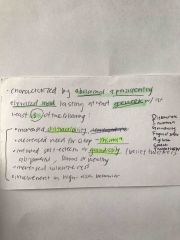
Back (Definition) |
|
|
Manic Episodes |

Back (Definition) |
|
|
Bipolar I |
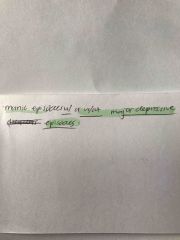
Back (Definition) |
|
|
Manic Episodes |
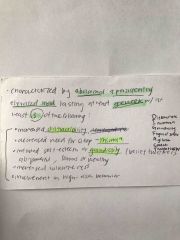
Back (Definition) |
|
|
Bipolar I |

|
|
|
Bipolar II |

Back (Definition) |
|
|
Cyclothymic disorder |
Combination of hypomanic disorder and periods of dysthmia that are not severe enough to qualify as major depressive episodes |
|
|
PTSD diagnosis |
Person must have a number of the symptoms for at least one month |
|
|
Dissociative amnesia |
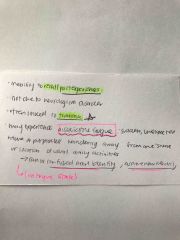
Back (Definition) |
|
|
Dissociative identity disorder |
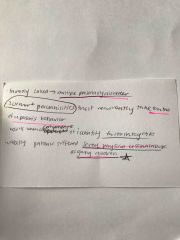
Back (Definition) |
|
|
Conversion disorder |
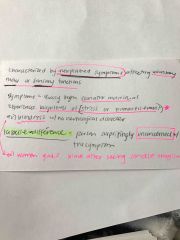
Back (Definition) |
|
|
Schizoid PD |
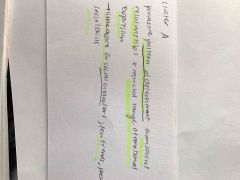
Back (Definition) |
|
|
Borderline PD |
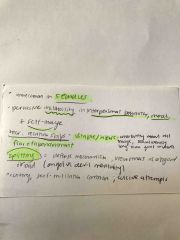
Cluster B |
|
|
Borderline PD |

Cluster B |
|
|
Avoidant PD CLUSTER C |
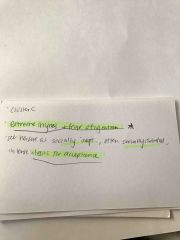
Back (Definition) |
|
|
What are the hallmarks of a TRUE experiment? |
One of the hallmarks of a true experiment is that research participants are randomly assigned to the various experimental and control groups. This allows for the experimenter to control and manipulating the independent variable |
|
|
Chronic stress is correlated with atrophy of which brain structure? |
Hippocampus |
|
|
What are the four types of social support? |
social support into four types: (1) Emotional social support, (e.g, validation, love, expressions of care), (2) Instrumental social support (e.g., money, transportation, housing), (3) Informational social support (e.g., knowledge about how to do something or acquire a resource) (4) Appraisal social support (e.g., self-evaluative information, affirmation, constructive feedback). |
|
|
What is self-selection bias? |
It is related to the reality that certain groups of people may be more willing than others to participate in a study, and therefore the sample may not be an accurate reflection of the population (e.g., among regular newspaper readers and non-readers of newspapers, the former are far more likely to respond to a survey about newspapers or other media). |
|
|
What neurotransmitter is likely elevated in someone with anxiety disorder? |
Glutamate is a neurotransmitter that increases activity in the brain’s alarm centers and is known to be increased in those who suffer from an anxiety disorder. |
|
|
What is the diathesis stress model? |
A diathesis stress model focuses on how biological predispositions (like genes or other biological traits) interact with environmental factors to result in disease. |
|
|
What do psyhchodynamic theories focus on? |
Many psychodynamic theories focus on how experiences in childhood shape adulthood. |
|
|
Some have trouble relating to society around them and feel trapped by institutions and bureaucratic policies that fail to give them equality, a situation commonly known as the “iron cage.” Which sociological thinker developed the concept of the iron cage? |
Max Weber’s theories of symbolic interactionism emphasize how individuals relate to society, and one of his ideas was the concept of the iron cage. He believed that the experience of the “iron cage” led to disenchantment with society. |
|
|
Functionalist theory |
Functionalist theory is concerned with finding out how existing social structures promote social stability. It typically concerns itself with the interaction of macro-level institutions and social structures rather than individuals’ beliefs and identities. |
|
|
What and who is behaviorism associated with? |
Behaviorism is related to the theories of B.F. Skinner. It is a school of psychological research that focuses on individual behavior alone, ignoring mental states such as beliefs and identities. |
|
|
What is effective agency? |
The sense of agency is the sense that you feel in control of your life, in control of your thoughts and behavior, and able to handle a wide range of life problems successfully. It is the capability of individuals to act freely and make independent choices |
|
|
Meissner Corpuscles |
As stated in the passage, SA1 neurons terminate in Meissner’s corpuscles. These neurons are responsible for touch, which is the purpose of mechanoreceptors. |
|
|
What is gender dysphoria? |
Gender dysphoria is the feeling of stress or discomfort in which one's sense of one's gender does not align with the gender assigned at birth (overwhelmingly the physiological sex of the person as determined by primary sex characteristics) |
|
|
What is paraphilia? |
Paraphilia is the experience of intense sexual arousal to atypical objects, situations, or individuals. |
|
|
What is general paresis? |
General paresis, also known as general paralysis of the insane or paralytic dementia, is a neuropsychiatric disorder affecting the brain, caused by late-stage syphilis. |
|
|
What is delirium tremens? |
Delirium tremens is an acute episode of delirium that is usually caused by withdrawal from alcohol. |
|
|
Social Learning Theory? By Who? |
Vygotsky’s social learning theory heavily stresses the role of people and interactions in language acquisition, which would involve mirror neurons. |
|
|
What is the affect heuristic? |
The affect heuristic is the process of making a judgment based on emotions that are evoked. |
|
|
What is anomie? |
This refers to a lack of social norms which leads to a breakdown in the connection between an individual and their community |
|
|
What characterizes a periphery nation |
These are nations that are less economically developed with weak governments and institutions and they are also dependent on a different country (core nation) |
|
|
Birth rate |
Number of births per 1000 people per year |
|
|
Birth rate |
Number of births per 1000 people per year |
|
|
Death rate |
Number of deaths per 1000 people per year |
|
|
What is regression to the mean? |
Regression to the mean refers to responses becoming less extreme when participants are assessed again, instead of becoming less moderate or average. |
|
|
One explanation for the development of personality uses the biological perspective, which emphasizes the influence of genetics and brain biology in determining an individual’s behavioral, emotional, and cognitive patterns. Which of the following psychologists’ views are most closely aligned with this perspective? |
Hans Eysenck |
|
|
Who is Hans Eysenck? |
Hans Eysenck is noted for the first empirical study he published on genetics of personality in 1951, which investigated the trait of neuroticism in identical (i.e., monozygotic) and fraternal (i.e., dizygotic twins). |
|
|
Who is Gordon Allport? |
Gordon Allport is known in connection to the trait perspective of personality. He argued that three key types of traits contribute to personality: cardinal traits, central traits, and secondary traits. |
|
|
Projection and rationalization serve as ego defense mechanisms in those affected by BPD. In which portions of the mind would Sigmund Freud argue that the ego functions in these individuals? |
Sigmund Freud defined the ego as the principle which drives to please the id in realistic ways that will provide benefit (and reduce grief) in the long term. It has the capacity to act through the conscious mind (i.e., awareness at the present moment), the unconscious mind (i.e., processes that occur automatically in the mind and are not available to introspection), and the preconscious mind (i.e., thoughts in the minds that are unconscious but can be recalled if necessary). |
|
|
In sociology, what does prescriptive and descriptive refer to? |
In sociology, prescriptive refers to what an individual believes should occur, while descriptive refers to what one perceives as actually occurring. |
|
|
What is dual coding? |
Ex) By associating the numbers with different animals, HM was attempting to assign each number to a mental image to be processed at a more connected level. This is the premise of dual coding. |
|
|
What is cerebellum responsible for? |
The cerebellum is responsible for motor functions and some memory of those functions. |
|
|
Sociologists have found that for first-generation immigrants from West African nations, health outcomes and healthcare disparities are relatively minor compared to white and Asian populations, whereas the children of West African immigrants experience health outcomes and healthcare disparities nearly aligned with US-born African American populations. This sharp downward change in a single generation is likely: |
due to increased social and cultural integration in the US. Children who are born in the US tend to show outcomes that are similar to other US-born people in the same demographic group. This demonstrates that the second-generation immigrant children have socially integrated more fully into the US culture. |
|
|
What is a crossover design? |
A crossover design occurs when participants participate in each group in a study. |
|
|
What is the elaboration likelihood model?
|
The elaboration likelihood model is a theory in psychology about how peoples attitudes are created and changed. There are 2 routes of processing. !) Peripheral route: depend more on intuition and emotion than the factual info itself. This tends to do with information that the subject either has no interest in or is unable to understand. 2) central route: processes info that the subject has the ability and motivation to understand. Have a higher cognitive aspect and therefore are more concrete |
|
|
What can meditation be an example of, for those that practice it within their culture? |
A FOLKWAY describes a traditional behavior that is learned from a social group. |
|
|
AN individual comes from a wealthy family but loses almost all of his money from a risky financial investment. This is an example of... |
Intragenerational mobility- occurs within an individual's lifetime and is due to their own actions rather than those of their ancestors. |
|
|
What is priming? |
A process by which a group is shown info that would bias them toward one answer. |
|
|
What is top-down processing? |
THis occurs when more complex brain functions such as memory or attention (which occur at the "top" or end of the sensory pathways) affect pathways involved in signal transduction (which occur in the "bottom" or earlier in sensory pathways ex) utilizing prior experiences to make perception more efficient |
|
|
What are the three components of attitude? |
ABC MODEL Affective: refers to emotional aspect Behavioral: actions associated with attitude, how the individual behaves Cognitive: what person thinks |
|
|
What is a proximal stimulus? |
The stimulus registered by sensory receptors (E.g. The pattern of light falling on the retina) |
|
|
When does an infant start to display stranger anxiety? |
Around 8 months |
|
|
What is place theory? |
Place theory posits that one is able to hear different pitches because the different sound waves trigger activity at different places along the cochlea's basilar membrane |
|
|
What is a primary and secondary reinforcer? |
Primary= physiological needs 2ndary= ex) money |
|
|
What type of info are people unlikely to automatically process? |
Novel info |
|
|
In a person with a severed corpus callosum, what experimental setup would result in a person saying "ball" after a researcher asks "what do you see?" |
The word ball projected to the right visual field while room is presented to the left |
|
|
What is likely to happen in a person in a state of dissonance who's actions conflict with their beliefs? Ex) working for a city council member but not agreeing on their policies |
They are likely to adapt their attitudes to be more in line with the council member; bc people usually change their attitudes to match their behaviors |
|
|
What is Thomas theorem? |
The interpretation of the situation causes the action;
Ex) toilet paper panic; rumor of an expected shortage of toilet paper caused people to stockpile toilet paper causing a shortage , which validates the rumor
Also example of self fulfilling prophecy |
|
|
What is an example of shadowing ? |
An experimental technique in which subjects repeat speech immediately after hearing it |
|
|
What are the range for scores of an IQ test? |
Scores are normalized to a mean of 100 and a standard deviation of 15; so 68% of the scores will be between 85 and 115 |
|
|
What is instinctual drift? |
The phenomenon whereby established habits, learned using operant conditioning techniques, eventually are replaced by innate food related behavior
Ex) trying to teach racoon to put coin in jar but ends up rubbing them together and dipping them in the container ; which is an instinctual behavior they do to wash food in a stream |
|
|
What are proximal and distal stimuli |
Proximal- the light reflected off an object in the external world, which excited receptors in our eyes creating an internal sensory response
Distal- the actual signal source ; objects and events out in the world |
|
|
What is cultural capital? |
The knowledge skills and education and similar characteristics that are used to make social distinctions and that are associated with differences in social status |
|
|
At what age is a child likely to respond to any caregiver based on attachment theory? |
3 months |
|
|
At what age is a child likely to recognize certain caregivers but still accept care from anyone ? |
4-6 months |
|
|
At what age is a child likely to recognize certain caregivers but still accept care from anyone ? |
4-6 months |
|
|
At what age does a child have a strong attachment to a single caregiver based on attachment theory? |
6-9 months |
|
|
At what age is a child likely to recognize certain caregivers but still accept care from anyone ? |
4-6 months |
|
|
At what age does a child have a strong attachment to a single caregiver based on attachment theory? |
6-9 months |
|
|
What is an escape / avoidance stimulus? |
Provoked escape or avoidance behavior to end stimulus |
|
|
Who created the five factor theory of personality? |
Eyesnyck |
|
|
What are the steps in the Kubler Ross model? |
DEATH ALWAYS BRINGS DEFINITE ACCEPTANCE
Denial Anger Bargaining Depression Acceptance |
|
|
What is social stratification? |
Refers to the objective hierarchy in society, and often more specifically addresses the class-based hierarchy. |
|
|
What hemisphere is prosody located? |
Right hem |
|
|
what is the central executive?
|
The Central Executive supervises the cognitive process of memory. |
|
|
How long is the phonological store? |
It is believed that the phonological store capacity is around 2 seconds. |
|
|
Type I error? |
A Type I error, or a false positive, is the incorrect rejection of the null hypothesis. |
|
|
Type II error |
A Type II error, or a false negative, is the incorrect acceptance of a null hypothesis that is actually false. |
|
|
Who created looking glass self? |
Charles Cooley |
|
|
Who created functionalism? |
Emile Durkheim |
|
|
Who created conflic theory? |
Karl Marx |
|
|
Motion parallax |
Motion parallax, or relative motion, is another monocular cue. When you are moving, objects closer than your point of visual focus move in direction opposite to you, while objects beyond your focus point move in same direction. |
|
|
Relative height |
is a monocular cue that provides information about distance. Objects higher are perceived to be further away than those lower. |
|
|
Retinal disparity |
Retinal disparity is a binocular depth cue that gives you a slightly different view of the same object and contributes to depth perception. |
|
|
Relative size |
Relative size is a monocular cue that allows us to infer distance. If two objects are similar in size in the real world, the one that casts a smaller retinal image is perceived to be further away. |
|
|
Interposition |
Interposition is a monocular cue that allows us to infer position. If one object is blocking another, it is perceived as being closer |
|
|
Binocular disparity |
Binocular disparity relies on the different images seen by each eye to determine depth, but still takes each image as a separate piece of information. |
|
|
Convergence |
Convergence relies on both eyes working together to create a single image that helps to determine depth. |
|
|
What are monocular cues? |
relative size-gives us idea of the form of the object; example of picture of two ants, since one is bigger, it is assumed to be closer because ants are the same size, interposition- ex: only need one eye to see that rectangle is over the oval, hence we assume its closer; relative height- |
|
|
Binocular cues |
Binocular cues- retinal disparity- eyes are 2.5 inches from each other and give us different views, convergence-when we look at things far our eyes relaxed; when look at things close, the muscles in our eyes turn our eyes toward the object |
|
|
Phototransduction cascade of rod |
Rod is made of tons of stacked discs, within discs there are lots of proteins: protein=rhodopsin, made up is 7subunits, sitting inside of protein= retinal-when light hits molecule causes retinal from being all cis-retinal to all TRANS-retinal -> This causes the rhodopsin to change shape as well- begins cascade- transducin- has alpha, beta, and gamma subunits-when retinal changes shape, transducin breaks away from rhodopsin, and the alpha subunit comes to another part of the disc and binds cyclic GMP phosphodiesterase (PDE)-PDE, when activated, takes cyclic GMP and converts to GMP- increase [GMP]-Na+ channels lining the cell- for it to be open= need cGMP-as GMP increases- causes Na+ channels to close= less Na+ enters the cell=hyperpolarization of cell= rods turn offWITHOUT LIGHT- rods on-turn off blpolar cell= off-center bipolar cellWITH LIGHT- rods off- bipolar cell on=on-center bipolar cell- when turned on, activates retinal ganglion cell- sends an azon to the optic nerve |
|
|
Photopic vision |
Photopic vision occurs at levels of high light levels. |
|
|
Mesopic vision |
Mesopic vision occurs at dawn or dusk and involves both rods and cones. |
|
|
Joint attention |
Joint attention is the focusing of attention on an object by two separate individuals. |
|
|
Selective attention |
Selective attention is the ability to maintain attention while being presented with masking or interfering stimuli. |
|
|
Directed attention |
Directed attention allows attention to be focused sustainably on a single task, in this case a single orientation of the Necker cube. |
|
|
cone of confusion |
All of the points on the cone of confusion have the same interaural level difference and interaural time difference |
|
|
What moves when pressure changes in inner ear? |
Pressure change in the ear: The pressure change causes the tectorial membrane to move laterally, not vertically. The pressure change causes the organ of Corti to vibrate vertically. |
|
|
Convergent intelligence ? By Who? |
Convergent intelligence was proposed by Guilford to describe IQ test related intelligence, such as puzzles, vocabulary words, and arithmetic. |
|
|
What does caffeine affect? |
Caffeine inhibits an enzyme that breaks down cyclic adenosine monophosphate (cAMP). The increase in cAMP increases glutamate production. This increase in cellular activity results in action potentials that are briefer and released in bursts. |
|
|
Insufflation |
Insufflation, inhaling drugs through the nose, is highly addictive but less addictive than drugs that are injected. |
|
|
Cross tolerance |
Cross tolerance is a reduction in the efficacy or responsiveness to a novel drug due to a common CNS target. EX: Alcohol and benzodiazepines work on the GabaA, receptor complex. |
|
|
Extensor plantar response |
The extensor plantar response (or babinski reflex) is a sign of upper motor neuron dysfunction and can be seen when a noxious stimuli is placed on the bottom of the foot, causing the toes to go into extension away from the bottom of the foot, rather than flexing down in the direction of the bottom of the foot. |
|
|
Clonus |
The involuntary rhythmic contraction of antagonist muscles is known as clonus and is a sign of upper motor neuron dysfunction. |
|
|
Damage to the right cerebral hemisphere would result in... |
somatosensory loss on the opposite side of the body. The left side of the body would be affected by the injury. |
|
|
Where are senses and motor functions processed |
Senses and motor functions are typically processed on the side of the cortex that is opposite from where the information was received. |
|
|
Gangliosides are found on ... |
Schwann cells, the myelin sheath cells of the peripheral nervous system. |
|
|
Where do microglia and the immune system arise from? |
Microglia are the macrophages, or phagocytes, of the central nervous system (CNS, or the brain). They will proliferate if there is an infection, such as bacterial meningitis. |
|
|
Depression and Potentiation |
Depression refers to neuroplasticity that results in activity and response growing weaker. Potentiation refers to neuroplasticity that activity and response growing stronger. |
|
|
Topographic memory |
is the ability to recognize places or to orient oneself to a particular space. |
|
|
Where do phermones bind? |
Pheromones bind to receptors in the accessory olfactory epithelium while standard odor molecules bind to receptors in the olfactory epithelium. |
|
|
Receptor and pathway for an odorant receptor |
The odorant receptor is a G-protein coupled receptor (GPCR) that opens cAMP gated ion channels, as well as activates adenylate cyclase to elicit various cAMP dependent protein kinases to affect a wide range of intracellular pathways. |
|
|
Population momentum refers to ... |
population growth at the national level that would occur even if levels of childbearing (births) immediately declined. Mexico has more people in younger age categories compared to the US and the world average, and more women at the childbearing age. Mexico is the best demonstration of “population momentum”. |
|
|
The church clock fallacy is ... |
the mistaken attribution of the synchronization of mating based on a common external reference rather than the active decisions of two individuals. |
|
|
Conflict theory |
In conflict theory, the thesis describes the initial environment, the status quo. The anti-thesis is the reaction to the thesis, the push-back from those unhappy with the status quo. |
|
|
Peripheral route processing |
When groups care about how information is presented over the information itself, their changes in attitudes are associated with the peripheral route to persuasion. (elaboration likelihood model) |
|
|
Covariation model |
In the covariation model, you (the perceiver) use multiple observations (actor, object, context) to determine the cause of the yelling behavior. |
|
|
The period prevalence |
is the proportion of a specific population exhibiting a certain characteristic, assessed over a specific period of time. People over the age of 50 have the lowest period prevalence of any age group. Men have a much lower period prevalence than women. Although people between the ages of 26 and 49 experience more than people over the age of 50, they are less likely to experience a major depressive episode than women as a group. |
|
|
Nativism in language |
Universalism/Nativisism- thought determines language; thought processes are universal to all human beings, outside the influence of language. |
|
|
Mary Ainsworth’s Strange Situation : |
done to try to understand why some have stranger anxiety and some don’t. Differences in parenting style: Parenting styles can be authoritarian, permissive, or authoritative (best). |
|
|
Empathy-Altruism Hypothesis |
suggests some people are altruistic due to empathy. Those who score higher on empathy are more altruistic. |
|
|
Cost signalling (altruism) |
– signals to others that person who’s giving has resources. People have increased trust in those they know have helped others in the past. |
|
|
Who created dramaturgical approache? |
Erving Goffman |
|
|
Side-effect discrimination – |
talks about how one institution/sector can influence another negatively. Ex. a small town where African American always get unfair verdict of guilty. Then while applying to a job later, don’t get the job because of record. Criminal justice reached unfair verdict, and potential employers are swayed too. Part of unintentional discrimination |
|
|
Past-In-Present discrimination – |
how things done in the past, even if no longer allowed they can have consequences for people in the present. Ex. After Brown vs. Board verdict, but girl in integrated school still doesn’t feel welcome in her classroom. Part of unintentional discrimination |
|
|
McDonaldization |
– fast food organizations have come to dominate other organizations in society. Principles of efficiency, calculability, predictability, and control – have dominated everything, from medicine to sporting events to entertainment, ex. movie theatres all look and work similarly, with same brands and movies. |
|
|
Who created the characteristics of an ideal bureacracy |
Max weber |
|
|
ideal bureacracy |
Division of labour – people are trained to do specific tasks. Pro – people are better at tasks, and increased efficiency. Con – increase alienation in workers, separating them from other works, and they don’t see work from beginning to end. Also trained incapacity, where workers are so specialized lose touch with overall picture. Hierarchy of organization – each position is under supervision of higher authority. Pro – clarify who’s in commandCon – deprive people of voice in decision making, and shirk responsibility, especially in unethical tasks. Also allows them to hide mistakes. Written rules and regulations Pro – clear expectations, uniform performance, equal treatment of all employees, and sense of unity/continuity to organization.Con – stiffens creativity, and if too much structure discourage employees from taking initiative. Goal displacement (rules become more important than goals) Impersonality – how individuals and officials conduct activities in unbiased mannerPro - equal treatmentCon – alienation, discourage loyalty to the groupEmployment based on technical qualifications –hiring in bureaucracy is based on qualifications on person has and not favouritismPro – decrease discrimination Con – decrease ambition (only secure job and do nothing more). Peter Principle, where every employee in hierarchy keeps getting promoted until they reach level of incompetence. |
|
|
Random mating |
Random mating- all equally likely to mate with each other, not influenced by environment/heredity or social limitation. Ensures a large amount of genetic diversity. |
|
|
Assortative Mating |
Assortative Mating – Non-random mating where individuals with certain personalities tend to mate with each other at a higher frequency, ex. large animals with large animals. Problem is if animals too genetically similar mate (inbreeding), can be harmful to species overall. |
|
|
Disassortative Mating (Non-Assortative Mating) |
– opposite of assortative mating – situation where individuals with different or diverse traits mate with higher frequency than with random mating. |
|
|
Who developed symbolic interactionism? |
Mead |
|
|
Who continued the work on symbolic. interact? |
Herbert Blumer: continued Mead’s work. He proposed 3 tenants to explain symbolic interactionism:1. We act based on meaning we’ve given something, ex. tree is place to rest.2. Different people assign different meanings to things. We give meaning to things based on social interactions, ex. someone tells us tree is infested with ants. But we have different views of the tree and we act differently. 3. The meaning we give something isn’t permanent, ex. something bites my back, so might not sit under next one I find. |
|
|
World-Systems Theory – |
importance of world as a unit, divides world into 3 countries: core, periphery, and semi-periphery. Core = Western Europe and US. Periphery = Latin America and Africa. Greatly influenced by and depend on core countries and transnational corporations. Semi-periphery = India and Brazil, middle-ground. |
|
|
Modernization Theory – |
all countries follow similar path of development to modern society. With some help traditional countries can develop similarly to today’s developed countries did. |
|
|
Dependency Theory – |
Reaction to Modernization theory. Uses idea of Core + Periphery countries to look at inequalities. Periphery countries export resources to Core countries, and don’t have means to develop. |
|
|
Hyperglobalist Perspective |
seed it as a new age in human history countries become interdependent and nation states themselves are less important. Don’t agree if good or bad. |
|
|
Skeptical Perspective – |
critical, considers it as being regionalized instead of globalized. Third world countries aren’t being integrated into global economy with same benefits. |
|
|
Transformationalist Perspective - |
doesn’t have specific cause or outcome. Believe national governments are changing, perhaps becoming less important but difficult to explain change so simply. They see the world order is changing. Just a new world order is being designed. Outcome unknown. |
|
|
Resource Mobilization Theory – |
looks at social movements from different angle. Instead of looking at deprivation of people, focuses on factors that help/hinder a social movement like access to resources. Need money, materials, political influence, media, and strong organizational base to recruit members – charismatic figure needed. Ex. Martin Luther King Jr. in Civil Rights Movement. |
|
|
Interactionist perspective |
looks at mass media on microlevel to see how it shapes day to day behavior. How mass media blurs line between solidary and group activities – ex. watching a movie. And how we connect with others using media changes over time (email instead of phone, or online dating). |
|
|
intragenerational mobility. |
If change in social class happens in a person’s own lifetime – |
|
|
Intergenerational mobility – |
change in social class between generations, ex. Parent is working class and son is working class. |
|
|
Reciprocal determinism? Who? |
BANDURA, says our behavior is both influences and is influenced by personal factors and the social environment |
|
|
Aversive racism |
a persistent avoidance of interaction with other racial and ethnic groups; thoughts and beliefs about the other group will be neutral or a mix of positive and negative; feelings and emotions about the group are negative though |
|
|
Example of aversive prejudice |
Feeling nervous in the presence of an out group even though cognitive thoughts and believes about the group are neutral |
|
|
Example of aversive prejudice |
Feeling nervous in the presence of an out group even though cognitive thoughts and believes about the group are neutral |
|
|
Example of domination prejudice |
Experiencing negative thoughts feelings and behaviors about members of an out group |
|
|
What doesn't change in an aging individual (cognitive wise)? |
Ability to retrieve general information ; semantic memory, crystallized intelligence |
|
|
Proximal Stimulus |
Stimulus registered by the sensory receptors (e.g the pattern of light falling on the retina) |
|
|
Distal Stimulus |
Distal Stimulus is any physical object or event in the external world that reflects light. |
|
|
EX) Seeing a word with a missing letter and being able to identify the word based on the sentence in which its contained is an example of??? |
CONTEXT EFFECTS / Top-down processing |
|
|
Which term is used to describe a memory report that is innaccurate but expressed with extreme confidence? |
False memory; can be observed in both real-world and laboratory settings |
|
|
When someone remembers every specific detail about a particular event, this represents..? Who came up with the theory? |
Flashbulb memory Brown and Kulik |
|
|
Who performed a study to measure the effect of removing the stomach on hunger |
Janowitz and Grossman |
|
|
Life course approach to health |
The life-course approach is defined as the long term effects on later health or disease risk of physical or social exposures during gestation, childhood, adolescence, young adulthood and later adult life. |
|
|
Socioeconomic gradient in health |
There is a social gradient in health that runs from top to bottom of the socioeconomic spectrum. This is a global phenomenon, seen in low, middle and high income countries. The social gradient in healthmeans that health inequities affect everyone |
|
|
Social epidemiology |
focuses on the contribution of social and cultural factors to disease patterns and populations |
|
|
cultural capital |
knowledge, skills, education and similar characteristics that are used to make social distinctions and that are associated with differences in social status |
|
|
Social cognitive/social learning theory |
behaviors are learned through observing others and modeling their actions |
|
|
symbolic interactionism |
examines small scale (or micro level) social interactions, focusing attention on how shared meaning is established among individuals or small groups |

